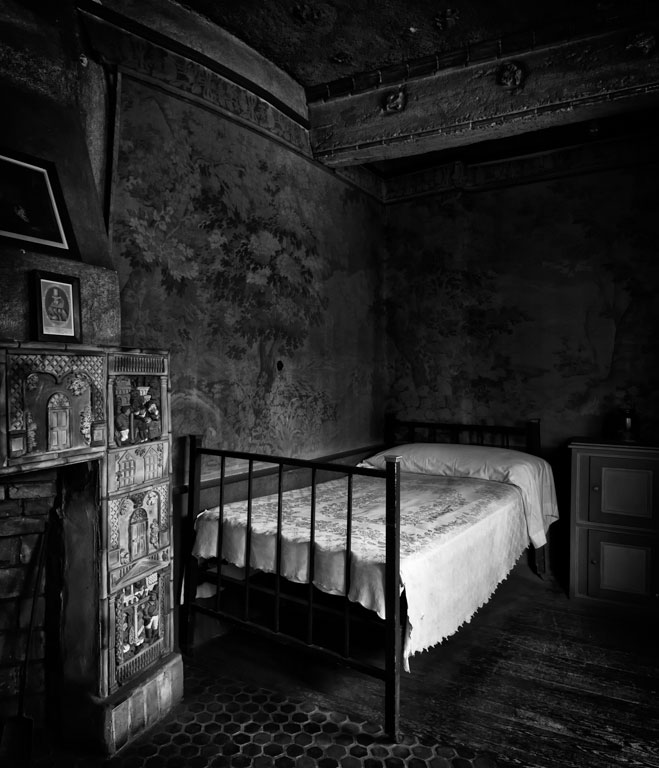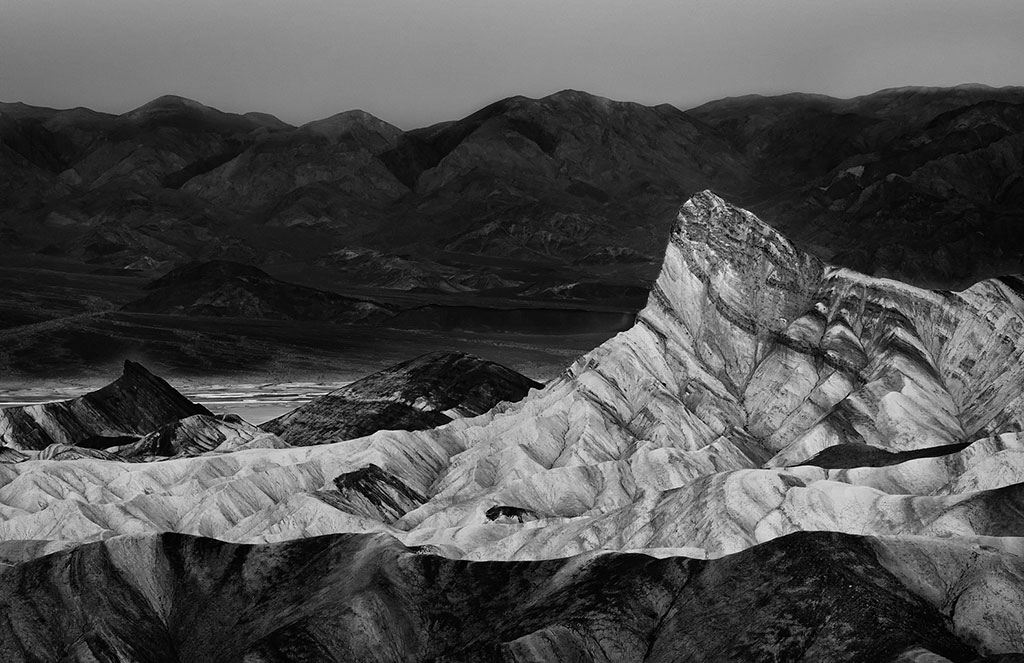A Challenging Landscape
Images and text by Arthur Ransome
The usual subject in my photography is the urban landscape, such as the following image that I created following a tour of Fonthill Castle in Pennsylvania.
Old, abandoned buildings are simply brimming with stories from the past. It is a subject I have photographed the most since beginning my pursuit of photography and it is one I feel comfortable with. Connecting with stories from the past allows me to create images that express my own thoughts, feelings, experiences and imagination. I was therefore initially hesitant when John Barclay asked me in late 2012 if I would be interested in taking part in a special Black and White photography workshop that he and his workshop partner, Dan Sniffin were arranging in Death Valley along with guest leader Chuck Kimmerle, one of the few modern day master B&W photographers. I have known John for some time and have enjoyed shooting with him at many different locations and simply talking photography – I find his work and perspective on life very inspiring. Therefore, an opportunity to spend a week learning from him and Dan should have been enough to make me sign up right away. Couple this with an opportunity to meet Chuck Kimmerle, whose work I have followed for as long as I can remember should have made signing up a no brainer. But my mind tumbled and turned, searching for answers to several questions I kept asking myself. I have never taken a photography workshop before and while Death Valley is a stunning location, the natural landscape doesn’t tell any stories, I thought. How can I impart feeling in images if no stories exist? But then I remembered something that John and I have talked about on several occasions. The subject is exactly that, it’s nothing more than a subject. You shoot one subject exactly the same way you shoot any subject and you simply need to bring to the table your own way of doing things – your own, unique technique and vision. I am constantly searching for a reason to do something (rather than to not do it) and this was the trigger. I signed up.
It has now been a week since I returned from my week-long adventure in Death Valley. And what an adventure it was. Stunning locations, great people, lots of fun and non-stop talking and thinking about photography. John, Dan and Chuck did an excellent job scouting out our trip and they were able to put together a packed itinerary that catered to our group. A nice, balanced combination of field shoots and classroom style presentations provided inspiration. Since this was my first workshop, I didn’t know what to expect. But John, Dan and Chuck eased any concerns I had during our meet and greet session on the first evening. They suggested that one purpose of a workshop is not to come away with stunning images, but rather to offer tools that we can use for our future growth. I figured that if this was achieved and, in the meantime, if I could come away with some images that I really liked then the workshop would be a success. And I wasn’t disappointed.
As I mentioned earlier, since the natural landscape isn’t my usual subject matter I wasn’t sure how I could recreate the feelings the stunning landscapes stirred up inside me. I just got to work taking photographs, convincing myself that somewhere amongst the hundreds of shutter actuations there had to be some good images that I could work on later. However, in addition to being on hand to answer any questions or offer advice, John, Dan and Chuck were also watching us work. Chuck pulled me aside after he had seen me set up and immediately begin snapping away at a scene. He suggested that rather than chasing the image and being afraid of missing the shot I should take some time, look around, connect with what I was looking at, let the image come to me and then go to work. I remember thinking “wow”. This is exactly what I do whenever I enter an old, abandoned building – I always stand or sit quietly and look around, letting my imagination run wild with stories from the past and it is only then, after I feel some form of connection to the place that I go to work. In this instance, I am not searching for the good image, but rather giving myself the chance to see the superb image. Despite the fact that John and I have previously agreed that you shoot one subject exactly the same way you shoot another, as much as I know the importance of letting the image come to me, when faced with a new subject matter I clearly didn’t follow my own way of doing things. My fear of missing the good image was blinkering my vision, which will always prevent us from seeing the superb image. A valuable lesson learned and although there were lots more ideas and lessons to take away from the workshop, this one in particular made the whole investment invaluable. I came away with a lesson that I will never forget, one that will shape my future in photography.
The following images are from Zabriskie Point and the Mesquite Dunes in Death Valley.





These are especially beautiful shots, John. Memorable.
Please pass along my thanks to Arthur for sharing his thoughts. It is quite clear he had a productive workshop.
I’m sure Arthur will be reading the responses.
Nicely written, Arthur. Very nice photos, too. Especially like the Zabriskie Point image. It was ingenious of John to have you write a column.
IN all honesty… it was you Chuck that suggested that Arthur write this. Thanks for the inspiration Chuck.
🙂
Well said and a nice couple of images with more to come I’m sure. The learning was not only from the instructors but from the other students as well.
Thanks to JB for giving me the opportunity to do this. Thanks also to everyone for the feedback.
Arthur, a wonderful article regarding John’s workshop. I hope and can join him next year for one of his workshops.
Wonderful article, Arthur! My initial photographic interests were mainly nature photography and had the same apprehension about shooting old abanded structures that you have about landscapes and nature. I’ve had the similar conversations with John about photography and have come to the same conclusions – there are more similarities than differences in these different subjects. Your Death Valley images are beautiful, just like your old abandoned buildings.
Great feedback Stan.
Thanks for posting this thoughtful article of Arthur’s. And, Arthur, your Zabriske Point image is superb, as is the abandoned building -equally moody and powerful and story worthy!